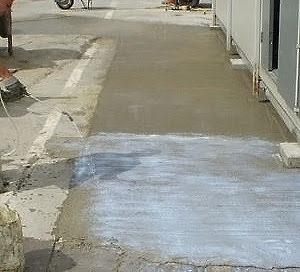Curing of Concrete
Curing: Curing of concrete is a process by which fresh wet concrete is allowed to complete its reaction to attained its desire strength. By this method concrete is protected against loss of moisture required for hydration and kept within the recommended temperature range.
Necessity of Curing of Concrete:
1) To enhance hydration of concrete to achieve desire strength.
2) Well cured concrete has minimum thermal, plastic and drying shrinkage crack which make concrete more water, tight results durable concrete.
3) Inadequate curing results weak and dusty surface of concrete, results a poor abrasion resistance.
Method of Curing of concrete:
Methods of curing of concrete are:
1) Ponding Method
2) Spraying of Water
3) Shading Concrete Work.
4) Covering Concreting Work
5) Stream Curing
6) Membrane Curing
Ponding Method: This is the best method of curing and suitable for horizontal surfacing work like floor, roof, pavement etc. In this method , concrete is covered with hessian cloth or plastic for first 24 hours. After that removed the covering material and concrete surfaces are divided with segments(ponds) by clay, mortar or other suitable materials and the segments (ponds) are filled with water. The filling of water in these pond are done twice or thrice a day depending on the atmospheric condition.
Spraying of Water: Spraying of water continuously on the concrete surface is an effective method of curing of concrete. The concrete should be allowed to set sufficiently before starting spraying of water on it. Curing of vertical members (i.e. column, wall etc) as well as horizontal surface cured by this method. This method demands high quantity of water.
Figure: Curing by Spraying of Water.
Covering Concreting Work: This is widely used method of curing, specially for structural concrete and hessian cloth, canvas or empty cement bag are used as covering material. After covering the surface, it is wetted periodically depending upon the rate of evaporation of water.
Stream Curing: Stream curing accelerate the rate of strength gaining of concrete by supplying heat and additional moisture in it. So curing time reduced remarkably. This method can best be used in pre-cast work.
Advantage:
a) Rapid hardening of concrete.
b) Quality can be assured in controlled environment.
c) Better in cold weather
Disadvantage:
a) Initial setup cost is high.
b) Curing work for large surface is complicated.
Membrane Curing: A method of curing where a liquid formed membrane sprayed over the freshly placed concrete's exposed surface shortly after the concreting work is finished. These membrane's makes the concrete surface impervious and thus hold the mixing water in the concrete body so that it can hydrate the cement over a period of time. This method of curing does not need constant supervision and suitable for areas where water is not easily available.
FAQ:
1) What is the minimum time for curing of concrete?
Answer: Curing period of concrete depends on types of cement used,types of construction, designed strength, ambient temperature,curing regime etc.As per ACI code at temperature higher than 5 ℃ the curing period is 7 days or until the concrete strength reaches at 70% of its specified compressive or flexural strength.
What is Curing of concrete??
Answer: Curing of concrete is a process by which fresh wet concrete is allowed to complete its reaction to attained its desire strength.
Curing of concrete methods
Define curing of concrete.














No comments:
Post a Comment